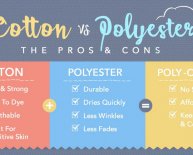
Pros and cons of polyester
There are many different types of fiber used to make carpet. In this section we are going to give you the PROS & CONS of the four most popular fibers, Nylon, Polyester, Olefin, and Wool.
Pros
- Good Elasticity – Nylon will stretch up to 33% of its length and still regain its original shape. This is very important in heavy traffic areas where furniture may be dragged across the carpet.
- Very Abrasion Resistant – It even surpasses wool. Many manufacturers offer wear guaranties.
- Static Resistant – Not its ancestry, but today’s fibers do very well.
- Heat Sets Well – When properly heat set, nylon retains its crimp, twist, and dye extremely well.
- Good resiliency – Nylon can be crushed for long periods and still regain its original shape.
- Non-Absorbent – Nylon dries quickly since it will absorb less than 8% of its weight in H20.
- Mildew Resistant – Nylon provides no food source, but mildew can grow on it if another food source is available. Notice the damage that can be done under an over watered potted plant.
- Nylon responds very well to most professional cleaning methods and treatments.
Cons
- Nylon is almost always acid dyed. It is rarely solution dyed, so it can have problems with bleaching, fading, urine reactions, etc.
Polyester
Polyester’s popularity seems to go up and down like a roller coaster. Because it’s relatively inexpensive to produce, manufacturers are regularly reintroducing this fiber to the carpet industry. Although it has some excellent qualities, and is a great fiber for clothing, it does have some limiting factors when used in carpet.
- Since polyester does not have dye sites, it is usually dyed with a disperse dye or solution dye method which makes it very resistant to bleaching, fading and soil dye reactions.
- Stain Resistant – This applies only to water based stains. Low Absorbency – Quick drying
- Polyester is difficult to dye and usually must be solution dyed which limits the variety.
- It is not resistant to oily stains, and in fact an oily spill or spot left without proper cleanup can oxidize and even chemically bond with and become part of the fiber. You need to know that some of these spots just won’t come out.
- Crimp Loss – Early polyester was a mess. A new polyester carpet was fuller, fluffier and more luxurious than anything on the market. Six-month-old polyester was an owner’s nightmare. Due to loss of twist and crimp, long strait fibers were left in the traffic areas, which caused matting and tangling and destroyed the original look of the carpet. Definite improvements have been made by heat setting and using finer yarns, but crimp loss can still be a problem. This is a characteristic of polyester, not a defect.
Olefin
Olefin is a very versatile carpet fiber. It is used in carpet backings (called polypropylene), face yarns and even astroturf. Olefin has become almost synonymous with one of its trade names “Herculon” a trademark owned by Hercules Corporation, a major manufacturer of olefin.
- Olefin is very moisture resistant. It will absorb only one tenth of 1% of its weight in water. This leads to some pros and some cons.
- Very difficult to stain.
- Great for outdoor applications (stadium or pool)
- Chemical Resistant – Most chemicals and bleaches won’t damage it at all
- Solution dyeing makes it resistant to fading.
- Lightweight – It is the only common carpet fiber that will float on water. ( Except celluloid)
- Strong – It wears well except for resiliency factor (see cons).
- It has good cleanability and stain release. (Except oil/petroleum-based stains – see cons)
- Olefin is not a resilient fiber. When crushed it does not regain its original shape easily. Traffic areas tend to lie down, showing “apparent soiling”. Furniture marks can be permanent reminders to the owner of where his furniture used to be.
- It is a very heat sensitive fiber. Its melting point is around 300 degrees but damage can occur at lower temperatures.
- Olefin can be damaged by Friction – Even dragging a heavy piece of furniture across an olefin carpet can cause permanent marks from the heat generated by friction.
- Like polyester, extended exposure to oil-based soils may become permanent.
- Olefin is very difficult to dye due to its low absorbency rate. It is almost always solution dyed.
- Quite often, Olefin is in a glue-down situation, which creates a potential to brown from soil wicking from the base of the yarns due to incomplete soil removal. Over wetting and/or slow drying increases the likelihood.
Wool
Wool comes from the fleece of sheep or lambs. This is one of the oldest fibers used by man, dating back over two thousand years. It is still one of the finest face yarns available for carpet. Wool is chemically made up of standard organic elements including sulfur, which accounts for the wool smell when it is damp.

















